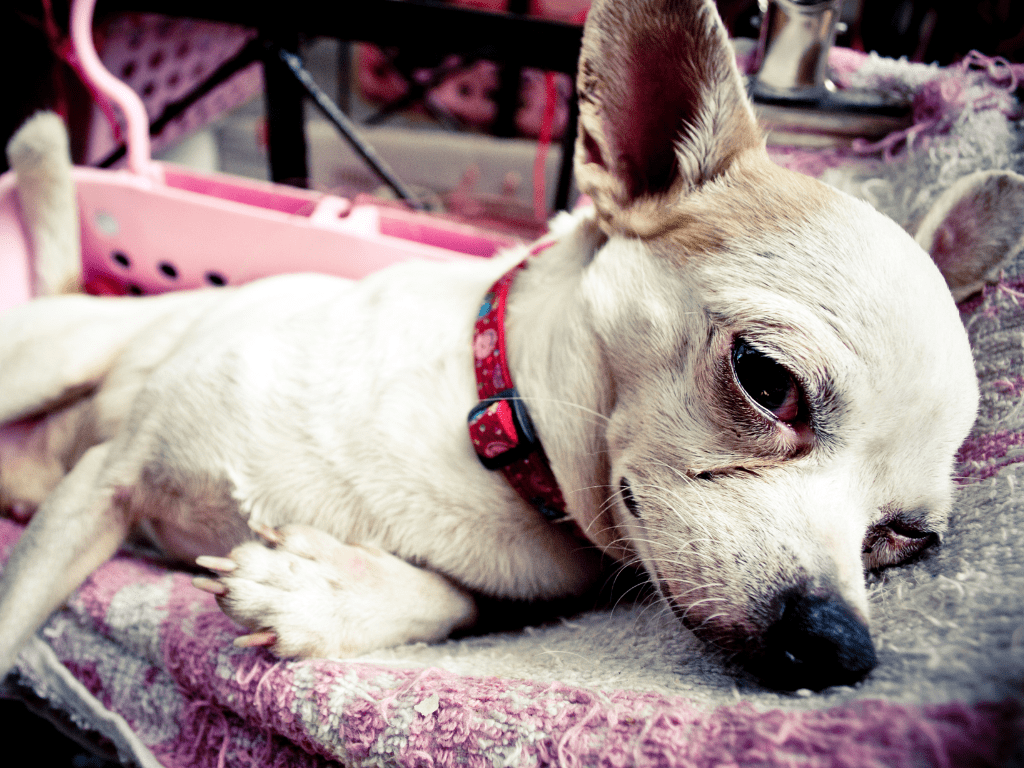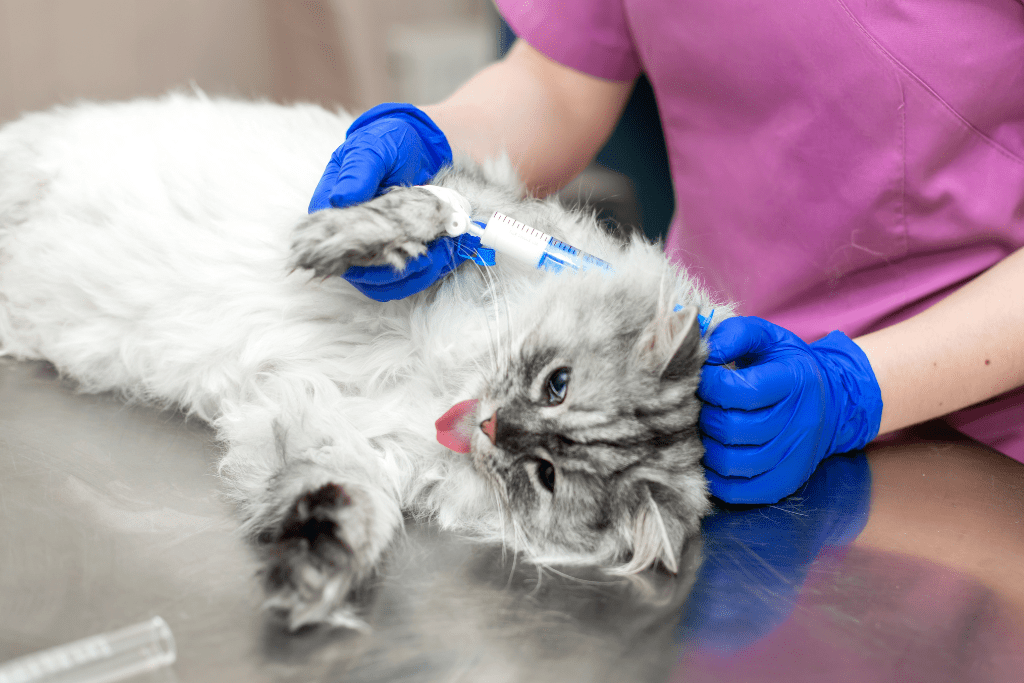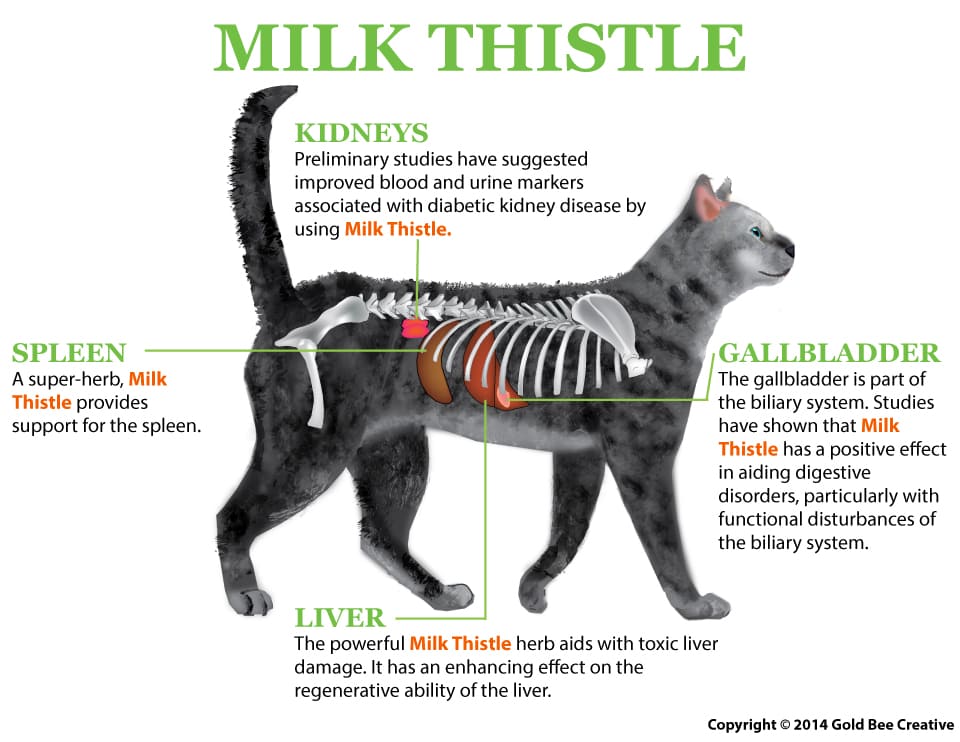liver support

free shipping over $100 (USA & Canada)
1-877-937-4372 the pet expert hotline

Gallstones in dogs and cats can be found in the cystic duct, intrahepatic bile ducts and gallbladder. Cholelithiasis or gallbladder stones are rare in dogs and cats, being in many cases incidental examination findings, or often only found at necropsies. However, they can cause acute extrahepatic bile duct obstruction, so knowing what are the signs and being proactive can help protect your pet.
Gallstones are asymptomatic in many cases. There are a few clinical signs, however, usually associated with cholecystitis or biliary obstruction. They are:
Gallstones are formed from the precipitation of cholesterol in small crystals on the surface of the mucosa of the inflamed gallbladder, and as they accumulate, they form larger stones. Seeing as in dogs and cats the concentration of cholesterol is lower than compared to humans, this condition is quite uncommon.
Other conditions that can result in the formation of gallstones are inflammatory, infectious processes and bile stasis. Diets high in cholesterol and deficient in taurine (amino acid), or methionine-deficient nutrition can also cause stones in the gallbladder. and overproduction of bilirubin during hemolysis (destruction of erythrocytes/red blood cells).
There are some particularities about stones in the gallbladder in dogs and cats. In dogs, gallstones can result from the malabsorption of free calcium into the bile from the gallbladder. As for genetic predisposition, young female dogs of small breeds and middle-aged older male cats may be at greater risk of developing gallstones.

If a gallstone diagnosis is suspected, the vet will examine the pet physically and might request detailed anamnesis and the following additional tests:
In cases of inflammation in the gallbladder, inflammation of the bile duct system or cholangiohepatitis associated with gallstones, clinical therapy should be performed, which varies depending on the root cause and symptoms.
When there are associated clinical symptoms and a confirmed diagnosis, the definitive treatment is surgery. In these cases, the veterinarian will remove the organ, a technique called cholecystectomy or video laparoscopy.
Before surgery, prophylaxis with antibiotic therapy should be performed. Dehydrated patients should also undergo fluid therapy to correct fluid and electrolyte imbalances resulting from vomiting.
Periodic consultations with the veterinarian can help detect changes early, before the worsening of the condition and the appearance of clinical symptoms. Feeding a balanced diet and supplementing the pet’s meals with natural supplements can also help.
At NHV we want dogs and cats to have the best supplements for proactive support or to help the recovery from gallbladder stones.
Supplements like NHV Milk Thistle can help to protect the animal’s liver and remove toxins. While NHV BK-Detox promotes vitality by detoxifying the lymphatic system and supporting the pet’s immunity.
NHV Turmeric is a potent anti-inflammatory with discomfort-relieving properties, while also helping the metabolism and the good function of several organs. All three combined are part of our Gallbladder Kit, which may help protect dogs and cats with gallbladder stones or related issues.
liver support

100% Natural Liver and Kidney Detox and Cancer Support in Cats
buy 2 and save $3
3 month supply for a small to medium size pet
A popular herb among conventional and holistic veterinarians, Milk Thistle is often recommended for cats who have liver disorders, are fighting cancer, diabetes, kidney issues, gallbladder and bile duct issues, as well as hyperthyroidism.


A popular herb among conventional and holistic veterinarians, Milk Thistle is often recommended for cats who have liver disorders, are fighting cancer, diabetes, kidney issues, gallbladder and bile duct issues, as well as hyperthyroidism.

Milk thistle, also known as Silybum Marianum is an herb that has been used for thousands of years by humans for its powerful medicinal properties. The active ingredient is Silymarin which contains flavonoids that have many beneficial properties including:
Milk thistle is one of the few herbs that have no equivalent in conventional medicine and has many uses. You can read about the many applications of Milk Thistle for cats and dogs on Dr. Hillary Cook's blog.
Milk Thistle for Liver Function
Milk Thistle for cats with liver disease is glycerin-based and safe for long-term use. This potent herbal formula provides excellent proactive support and can be taken in conjunction with conventional treatment.
Milk Thistle for Kidney Function
Milk Thistle for Anti-Cancer Support
Milk Thistle may also be beneficial to cats undergoing chemotherapy as Silymarium may enhance the activity of certain chemo drugs.
You can read Peachez's Story with Milk Thistle for cats and how it helped her with cancer and liver problems.
NHV’s certified organic Milk Thistle is a safe herb that is recommended and used by holistic practitioners. All of our products are all-natural and formulated by veterinarians with a focus on comprehensively supporting the health and well-being of your feline family member.
If you have questions about Milk Thistle or any of our plant-based products, ask an NHV expert because at NHV we want your kitty’s health to be purrfect!

NHV’s Milk Thistle for Cats contains just one ingredient.
Select your pet's weight to determine the correct dose.
To be taken twice daily. Determine your pet’s weight and then use the easy chart below to determine the correct dose. This is the minimum dosage.
Pet's Weight Dosage
0 - 15 lb = 0.5 ml
16 - 30 lb = 1.0 ml
31 - 45 lb = 1.5 ml
46 - 60 lb = 2.0 ml
61 - 75 lb = 2.5 ml
Over 75 lb = 3.0 ml
How to Administer
Shake well before use. The easiest method is to use the dropper provide and places the drops into your pet’s food or favorite treat. You can also use the dropper and squirt directly into the pet’s mouth.
Some pets can be finicky, if this occurs consider hiding the drops in foods most pet’s love such as fish, chicken or yogurt or a favorite treat. If your pet only eats dry food then soak a few kibbles at feeding time.
For Best Results
Herbal dietary supplements are beneficial to the health and wellbeing of your pet and are safe for long-term use. Every pet responds to natural herbal supplements differently, therefore it is important to be consistent and administer the product daily. Supplements generally take two to four weeks to take effect, however this will vary from one animal to the next.
Product Storage
All NHV Natural Pet Products are pure herbal extracts and contain no artificial additives, preservatives or coloring. Shelf life after opening is 6 months and must be refrigerated after opening.
Cautions and Contraindications
Do not use Milk Thistle in pregnant or nursing animals. Speak to your vet before using our products. A second visit is recommended if your pet’s condition does not improve, or deteriorates after continued use of the supplements.
All information provided by NHV Natural Pet Products is for educational purposes only.
Milk thistle, also known as Silybum Marianum is an herb that has been used for thousands of years by humans for its powerful medicinal properties. The active ingredient is Silymarin which contains flavonoids that have many beneficial properties including:
Milk thistle is one of the few herbs that have no equivalent in conventional medicine and has many uses. You can read about the many applications of Milk Thistle for cats and dogs on Dr. Hillary Cook's blog.
Milk Thistle for Liver Function
Milk Thistle for cats with liver disease is glycerin-based and safe for long-term use. This potent herbal formula provides excellent proactive support and can be taken in conjunction with conventional treatment.
Milk Thistle for Kidney Function
Milk Thistle for Anti-Cancer Support
Milk Thistle may also be beneficial to cats undergoing chemotherapy as Silymarium may enhance the activity of certain chemo drugs.
You can read Peachez's Story with Milk Thistle for cats and how it helped her with cancer and liver problems.
NHV’s certified organic Milk Thistle is a safe herb that is recommended and used by holistic practitioners. All of our products are all-natural and formulated by veterinarians with a focus on comprehensively supporting the health and well-being of your feline family member.
If you have questions about Milk Thistle or any of our plant-based products, ask an NHV expert because at NHV we want your kitty’s health to be purrfect!

NHV’s Milk Thistle for Cats contains just one ingredient.
Select your pet's weight to determine the correct dose.
To be taken twice daily. Determine your pet’s weight and then use the easy chart below to determine the correct dose. This is the minimum dosage.
Pet's Weight Dosage
0 - 15 lb = 0.5 ml
16 - 30 lb = 1.0 ml
31 - 45 lb = 1.5 ml
46 - 60 lb = 2.0 ml
61 - 75 lb = 2.5 ml
Over 75 lb = 3.0 ml
How to Administer
Shake well before use. The easiest method is to use the dropper provide and places the drops into your pet’s food or favorite treat. You can also use the dropper and squirt directly into the pet’s mouth.
Some pets can be finicky, if this occurs consider hiding the drops in foods most pet’s love such as fish, chicken or yogurt or a favorite treat. If your pet only eats dry food then soak a few kibbles at feeding time.
For Best Results
Herbal dietary supplements are beneficial to the health and wellbeing of your pet and are safe for long-term use. Every pet responds to natural herbal supplements differently, therefore it is important to be consistent and administer the product daily. Supplements generally take two to four weeks to take effect, however this will vary from one animal to the next.
Product Storage
All NHV Natural Pet Products are pure herbal extracts and contain no artificial additives, preservatives or coloring. Shelf life after opening is 6 months and must be refrigerated after opening.
Cautions and Contraindications
Do not use Milk Thistle in pregnant or nursing animals. Speak to your vet before using our products. A second visit is recommended if your pet’s condition does not improve, or deteriorates after continued use of the supplements.
All information provided by NHV Natural Pet Products is for educational purposes only.
gallbladder support

BK-Detox, Milk Thistle & Turmeric
bundle and save with pet expert kits
3 month supply for a small to medium size pet.
Your little one’s gallbladder stores bile (from their liver) that helps break down everything they eat (including medication). If their digestion needs a little extra support, our Gallbladder Kit can help improve bile flow, help prevent gallstones and support healthy organ function.


Your little one’s gallbladder stores bile (from their liver) that helps break down everything they eat (including medication). If their digestion needs a little extra support, our Gallbladder Kit can help improve bile flow, help prevent gallstones and support healthy organ function.

From sunrise until sundown, our furry friends are constantly on the prowl for anything they can sniff or gobble. Sometimes they ingest things that don't sit well with them, but luckily, their body has ways of breaking down anything they eat. The liver creates bile and stores it in the gallbladder to be used when the body needs to break down and carry nutrients into the small intestine or carry toxins out of the body. If your little one is experiencing a gallbladder issue, they may experience vomiting, diarrhea, low appetite, or sometimes a yellow tinge in the skin or eyes (jaundice). Our Gallbladder Kit can be used for proactive pet care as well as be helpful for more severe health conditions, like gallstones or liver disorders. NHV supplements are formulated to be taken alongside vet-prescribed medication so that you don't have to pick between a conventional or integrative approach - you can have both!
Like humans, healthy liver function is essential to your furkiddo's health and wellbeing. The liver filters everything that passes through their body, including harmful toxins and medication. Sometimes the gallbladder gets blocked, and stones can form from undigested cholesterol, calcium deposits, or bilirubin (a yellowish pigment that comes from the breakdown of red blood cells). NHV's Gallbladder Kit contains BK-Detox, Milk Thistle, and Turmeric. Ingredients in BK-Detox like Cleavers and Prickly Ash help flush the lymphatic system, improve detoxification of vital organs and help cleanse the blood to prevent future masses or blockages from forming. Other ingredients in BK-Detox, such as Burdock and Oregon Grape help stimulate bile(for improved digestion), cleanse blood (to help prevent stones) and support the immune system (to fight infection). The silymarin in Milk Thistle adds liver support by protecting liver cells from harmful toxins (so it is more easily eliminated) and encourages tissue regeneration. Turmeric adds extra antioxidant and anti-inflammatory support to improve circulation and provide relief.
With NHV Supplements, you can help provide your pet with the extra support they need to get their health back on track! Supplements like BK-Detox, Milk Thistle, and Turmeric are safe for long-term use, and all of our supplements are created by a holistic veterinarian and master herbalist with over 50 years of experience. We are always happy to help you so for any questions or concerns about gallbladder health, get in touch with a pet expert today!
Made with the finest, organically grown, or ethically harvested herbs. Made specifically for pets, vet-formulated, and vet approved.
BK-Detox
Milk Thistle
Turmeric
Select your pet's weight to determine the correct dose.
To be taken twice daily. Determine your pet’s weight and then use the easy chart below to determine the correct dose. This is the minimum dosage.
Pet's Weight Dosage
0 - 15 lb = 0.5 ml
16 - 30 lb = 1.0 ml
31 - 45 lb = 1.5 ml
46 - 60 lb = 2.0 ml
61 - 75 lb = 2.5 ml
Over 75 lb = 3.0 ml
How to Administer
Shake well before use. The easiest method is to use the dropper provided and place the drops into your pet’s food or favorite treat. You can also use the dropper and squirt directly into the pet’s mouth. Some pets can be finicky, if this occurs consider hiding the drops in foods most pet’s love such as fish, chicken or yogurt or a favorite treat. If your pet only eats dry food then soak a few kibbles at feeding time.
For Best Results
Herbal dietary supplements are beneficial to the health and well-being of your pet and are safe for long-term use. Every pet responds to natural herbal supplements differently, therefore it is important to be consistent and administer the product daily. Supplements generally take two to four weeks to take effect, however this will vary from one animal to the next.
Product Storage
All NHV Natural Pet Products are pure herbal extracts and contain no artificial additives, preservatives or coloring. Shelf life after opening is 6 months and must be refrigerated after opening.
Cautions and Contraindications
Do not use in pregnant or nursing animals.
All information provided by NHV Natural Pet Products is for educational purposes only.
From sunrise until sundown, our furry friends are constantly on the prowl for anything they can sniff or gobble. Sometimes they ingest things that don't sit well with them, but luckily, their body has ways of breaking down anything they eat. The liver creates bile and stores it in the gallbladder to be used when the body needs to break down and carry nutrients into the small intestine or carry toxins out of the body. If your little one is experiencing a gallbladder issue, they may experience vomiting, diarrhea, low appetite, or sometimes a yellow tinge in the skin or eyes (jaundice). Our Gallbladder Kit can be used for proactive pet care as well as be helpful for more severe health conditions, like gallstones or liver disorders. NHV supplements are formulated to be taken alongside vet-prescribed medication so that you don't have to pick between a conventional or integrative approach - you can have both!
Like humans, healthy liver function is essential to your furkiddo's health and wellbeing. The liver filters everything that passes through their body, including harmful toxins and medication. Sometimes the gallbladder gets blocked, and stones can form from undigested cholesterol, calcium deposits, or bilirubin (a yellowish pigment that comes from the breakdown of red blood cells). NHV's Gallbladder Kit contains BK-Detox, Milk Thistle, and Turmeric. Ingredients in BK-Detox like Cleavers and Prickly Ash help flush the lymphatic system, improve detoxification of vital organs and help cleanse the blood to prevent future masses or blockages from forming. Other ingredients in BK-Detox, such as Burdock and Oregon Grape help stimulate bile(for improved digestion), cleanse blood (to help prevent stones) and support the immune system (to fight infection). The silymarin in Milk Thistle adds liver support by protecting liver cells from harmful toxins (so it is more easily eliminated) and encourages tissue regeneration. Turmeric adds extra antioxidant and anti-inflammatory support to improve circulation and provide relief.
With NHV Supplements, you can help provide your pet with the extra support they need to get their health back on track! Supplements like BK-Detox, Milk Thistle, and Turmeric are safe for long-term use, and all of our supplements are created by a holistic veterinarian and master herbalist with over 50 years of experience. We are always happy to help you so for any questions or concerns about gallbladder health, get in touch with a pet expert today!
Made with the finest, organically grown, or ethically harvested herbs. Made specifically for pets, vet-formulated, and vet approved.
BK-Detox
Milk Thistle
Turmeric
Select your pet's weight to determine the correct dose.
To be taken twice daily. Determine your pet’s weight and then use the easy chart below to determine the correct dose. This is the minimum dosage.
Pet's Weight Dosage
0 - 15 lb = 0.5 ml
16 - 30 lb = 1.0 ml
31 - 45 lb = 1.5 ml
46 - 60 lb = 2.0 ml
61 - 75 lb = 2.5 ml
Over 75 lb = 3.0 ml
How to Administer
Shake well before use. The easiest method is to use the dropper provided and place the drops into your pet’s food or favorite treat. You can also use the dropper and squirt directly into the pet’s mouth. Some pets can be finicky, if this occurs consider hiding the drops in foods most pet’s love such as fish, chicken or yogurt or a favorite treat. If your pet only eats dry food then soak a few kibbles at feeding time.
For Best Results
Herbal dietary supplements are beneficial to the health and well-being of your pet and are safe for long-term use. Every pet responds to natural herbal supplements differently, therefore it is important to be consistent and administer the product daily. Supplements generally take two to four weeks to take effect, however this will vary from one animal to the next.
Product Storage
All NHV Natural Pet Products are pure herbal extracts and contain no artificial additives, preservatives or coloring. Shelf life after opening is 6 months and must be refrigerated after opening.
Cautions and Contraindications
Do not use in pregnant or nursing animals.
All information provided by NHV Natural Pet Products is for educational purposes only.
arthritis support

For Arthritis and Cancer Support
buy 2 and save $3
3 month supply for a small to medium size
Dogs love to root around in the dirt for goodies. But did you know one of the best things they could find would be turmeric? Turmeric for Dogs is a natural, antioxidant-rich supplement that supports your pup’s overall wellness.

Dogs love to root around in the dirt for goodies. But did you know one of the best things they could find would be turmeric? Turmeric for Dogs is a natural, antioxidant-rich supplement that supports your pup’s overall wellness.
Sadly, your pup won’t find turmeric in their backyards unless you live in the tropics, where this amazing plant grows. However, they can benefit from this golden plant by taking a full-spectrum extract of Turmeric for Dogs.
Is turmeric good for dogs? Yes, most pups can use this safe and gentle herb for a number of health concerns. This is thanks to the organic compounds produced by the plant.
If you’re the pet parent of a sick pup, you might have a challenging journey ahead. Remember that love you feel for your dog will also play a big role, and if you need a little advice, our pet experts are here for you and can be reached by chat.
How does this incredible spice work? Turmeric is rich in antioxidants, which can help your precious pet with stress, pollution, and illness. In the body, Turmeric has the potential to help with both overall.
Pets that are sick have increased oxidation, so the antioxidants they get from food, medication, or supplements can help give them the extra they need.
As pet-parents ourselves, we know you only want the best for your pup. That’s why our extracts are made from human-grade, high quality ingredients. And when you choose NHV Turmeric, you’re choosing decades of holistic pet wellness experience from vets and herbalists who can help support your pet’s wellness journey. Our formula is:
Our turmeric was formulated by a master herbalist and holistic vet. Learn more about Dr. Hillary Cook’s use of turmeric and its benefits for pet health. We are also proud to have been a part of many dog success stories, like with our doggo friend, Captain Morgan.
Captain Morgan’s story: “Our bloodhound has been on turmeric for 2 months now. He has been getting up and down more smoothly and not as stiff in his backend. He loves the taste and we love how it has helped him
You can add daily supplements like Turmeric to top up your dog’s intake of natural, wellness-promoting ingredients. It can be given directly by mouth with the dropper provided, or it can be mixed into food or a favorite treat (this tip is dog-approved)!
All NHV supplements are made with the finest quality organic or ethically harvested herbs. We use non-GMO vegetable glycerin as our base. NHV products are full-spectrum extracts.
Select your pet's weight to determine the correct dose.
To be taken twice daily. Determine your pet’s weight and then use the easy chart below to determine the correct dose. This is the minimum dosage.
Pet's Weight Dosage
0 - 15 lb = 0.5 ml
16 - 30 lb = 1.0 ml
31 - 45 lb = 1.5 ml
46 - 60 lb = 2.0 ml
61 - 75 lb = 2.5 ml
Over 75 lb = 3.0 ml
How to Administer
Shake well before use. The easiest method is to use the dropper provide and places the drops into your pet’s food or favorite treat. You can also use the dropper and squirt directly into the pet’s mouth.
Some pets can be finicky, if this occurs consider hiding the drops in foods most pet’s love such as fish, chicken or yogurt or a favorite treat. If your pet only eats dry food then soak a few kibbles at feeding time.
For Best Results
Herbal dietary supplements are beneficial to the health and wellbeing of your pet and are safe for long-term use. Every pet responds to natural herbal supplements differently, therefore it is important to be consistent and administer the product daily. Supplements generally take two to four weeks to take effect, however this will vary from one animal to the next.
Product Storage
All NHV Natural Pet Products are pure herbal extracts and contain no artificial additives, preservatives or coloring. Shelf life after opening is 6 months and must be refrigerated after opening.
Cautions and Contraindications: Do not use Turmeric in pregnant or nursing animals. Speak to your vet before using our products. A second visit is recommended if your pet’s condition does not improve, or deteriorates after continued use of the supplements.
Sadly, your pup won’t find turmeric in their backyards unless you live in the tropics, where this amazing plant grows. However, they can benefit from this golden plant by taking a full-spectrum extract of Turmeric for Dogs.
Is turmeric good for dogs? Yes, most pups can use this safe and gentle herb for a number of health concerns. This is thanks to the organic compounds produced by the plant.
If you’re the pet parent of a sick pup, you might have a challenging journey ahead. Remember that love you feel for your dog will also play a big role, and if you need a little advice, our pet experts are here for you and can be reached by chat.
How does this incredible spice work? Turmeric is rich in antioxidants, which can help your precious pet with stress, pollution, and illness. In the body, Turmeric has the potential to help with both overall.
Pets that are sick have increased oxidation, so the antioxidants they get from food, medication, or supplements can help give them the extra they need.
As pet-parents ourselves, we know you only want the best for your pup. That’s why our extracts are made from human-grade, high quality ingredients. And when you choose NHV Turmeric, you’re choosing decades of holistic pet wellness experience from vets and herbalists who can help support your pet’s wellness journey. Our formula is:
Our turmeric was formulated by a master herbalist and holistic vet. Learn more about Dr. Hillary Cook’s use of turmeric and its benefits for pet health. We are also proud to have been a part of many dog success stories, like with our doggo friend, Captain Morgan.
Captain Morgan’s story: “Our bloodhound has been on turmeric for 2 months now. He has been getting up and down more smoothly and not as stiff in his backend. He loves the taste and we love how it has helped him
You can add daily supplements like Turmeric to top up your dog’s intake of natural, wellness-promoting ingredients. It can be given directly by mouth with the dropper provided, or it can be mixed into food or a favorite treat (this tip is dog-approved)!
All NHV supplements are made with the finest quality organic or ethically harvested herbs. We use non-GMO vegetable glycerin as our base. NHV products are full-spectrum extracts.
Select your pet's weight to determine the correct dose.
To be taken twice daily. Determine your pet’s weight and then use the easy chart below to determine the correct dose. This is the minimum dosage.
Pet's Weight Dosage
0 - 15 lb = 0.5 ml
16 - 30 lb = 1.0 ml
31 - 45 lb = 1.5 ml
46 - 60 lb = 2.0 ml
61 - 75 lb = 2.5 ml
Over 75 lb = 3.0 ml
How to Administer
Shake well before use. The easiest method is to use the dropper provide and places the drops into your pet’s food or favorite treat. You can also use the dropper and squirt directly into the pet’s mouth.
Some pets can be finicky, if this occurs consider hiding the drops in foods most pet’s love such as fish, chicken or yogurt or a favorite treat. If your pet only eats dry food then soak a few kibbles at feeding time.
For Best Results
Herbal dietary supplements are beneficial to the health and wellbeing of your pet and are safe for long-term use. Every pet responds to natural herbal supplements differently, therefore it is important to be consistent and administer the product daily. Supplements generally take two to four weeks to take effect, however this will vary from one animal to the next.
Product Storage
All NHV Natural Pet Products are pure herbal extracts and contain no artificial additives, preservatives or coloring. Shelf life after opening is 6 months and must be refrigerated after opening.
Cautions and Contraindications: Do not use Turmeric in pregnant or nursing animals. Speak to your vet before using our products. A second visit is recommended if your pet’s condition does not improve, or deteriorates after continued use of the supplements.